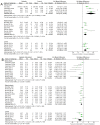Antioxidant Therapy Reduces Oxidative Stress, Restores Na,K-ATPase Function and Induces Neuroprotection in Rodent Models of Seizure and Epilepsy: A Systematic Review and Meta-Analysis
- PMID: 37507936
- PMCID: PMC10376594
- DOI: 10.3390/antiox12071397
Antioxidant Therapy Reduces Oxidative Stress, Restores Na,K-ATPase Function and Induces Neuroprotection in Rodent Models of Seizure and Epilepsy: A Systematic Review and Meta-Analysis
Abstract
Epilepsy is a neurological disorder characterized by epileptic seizures resulting from neuronal hyperexcitability, which may be related to failures in Na,K-ATPase activity and oxidative stress participation. We conducted this study to investigate the impact of antioxidant therapy on oxidative stress, Na,K-ATPase activity, seizure factors, and mortality in rodent seizure/epilepsy models induced by pentylenetetrazol (PTZ), pilocarpine (PILO), and kainic acid (KA). After screening 561 records in the MEDLINE, EMBASE, Web of Science, Science Direct, and Scopus databases, 22 were included in the systematic review following the PRISMA guidelines. The meta-analysis included 14 studies and showed that in epileptic animals there was an increase in the oxidizing agents nitric oxide (NO) and malondialdehyde (MDA), with a reduction in endogenous antioxidants reduced glutathione (GSH) and superoxide dismutase (SO). The Na,K-ATPase activity was reduced in all areas evaluated. Antioxidant therapy reversed all of these parameters altered by seizure or epilepsy induction. In addition, there was a percentage decrease in the number of seizures and mortality, and a meta-analysis showed a longer seizure latency in animals using antioxidant therapy. Thus, this study suggests that the use of antioxidants promotes neuroprotective effects and mitigates the effects of epilepsy. The protocol was registered in the Prospective Register of Systematic Reviews (PROSPERO) CRD42022356960.
Keywords: Na,K-ATPase; epilepsy; exogenous antioxidants; oxidative stress.
Conflict of interest statement
The authors declare no conflict of interest.
Figures








References
-
- Fisher R.S., Van Emde Boas W., Blume W., Elger C., Genton P., Lee P., Engel J. Epileptic Seizures and Epilepsy: Definitions Proposed by the International League Against Epilepsy (ILAE) and the International Bureau for Epilepsy (IBE) Epilepsia. 2005;46:470–472. doi: 10.1111/j.0013-9580.2005.66104.x. - DOI - PubMed
-
- Realmuto S., Zummo L., Cerami C., Agrò L., Dodich A., Canessa N., Zizzo A., Fierro B., Daniele O. Social Cognition Dysfunctions in Patients with Epilepsy: Evidence from Patients with Temporal Lobe and Idiopathic Generalized Epilepsies. Epilepsy Behav. 2015;47:98–103. doi: 10.1016/j.yebeh.2015.04.048. - DOI - PubMed
Publication types
Grants and funding
- APQ-0085-19/Fundação de Amparo à Pesquisa do Estado de Minas Gerais
- PPM-00307-18/Fundação de Amparo à Pesquisa do Estado de Minas Gerais
- 305441/2021-3/National Council for Scientific and Technological Development
- 403646/2021-9/National Council for Scientific and Technological Development
- Code 001/Coordenação de Aperfeicoamento de Pessoal de Nível Superior
LinkOut - more resources
Full Text Sources

